Exclusively Inclusive
What hand tool woodworking gives me.
I remember passing John’s workbench one evening a week or less ago. It was dark, but the light from my work area cast a soft blush on the end of his toolbox carcass. I wasn’t examining his dovetails, it was a certain level of perfection that caught my eye. Perfection for me comes in levels. There is no such thing as an ultimate level of perfection per se. Perfection, to me, is the level at which need is met. The four corners were meticulously joined in gapless union I find to be rarely ever seen. I recall snatches of him working in my mind’s eye and the reward of seeing him align every element of his body in delivering exactness to every cut to the wood. This too is more the rarity and scarcity to me as a maker in this age. I seldom see such things yet I know that they exist in small and ever-diminishing pockets around the world.
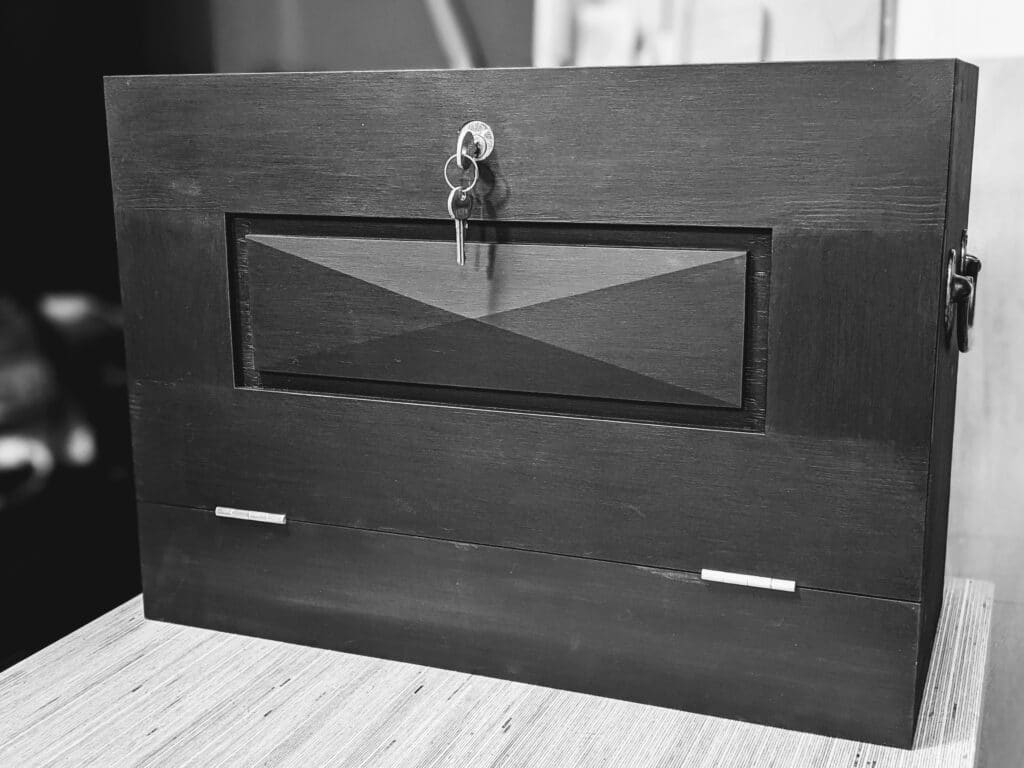
It made me think that, given the right input, the right encouragement, an environment of nurture and set-aside time, skilled work can thrive and succeed. John, as I watched him on and off through the days, never stopped moving. And he worked systematically and with sympathetic deliberation through the execution of his work.
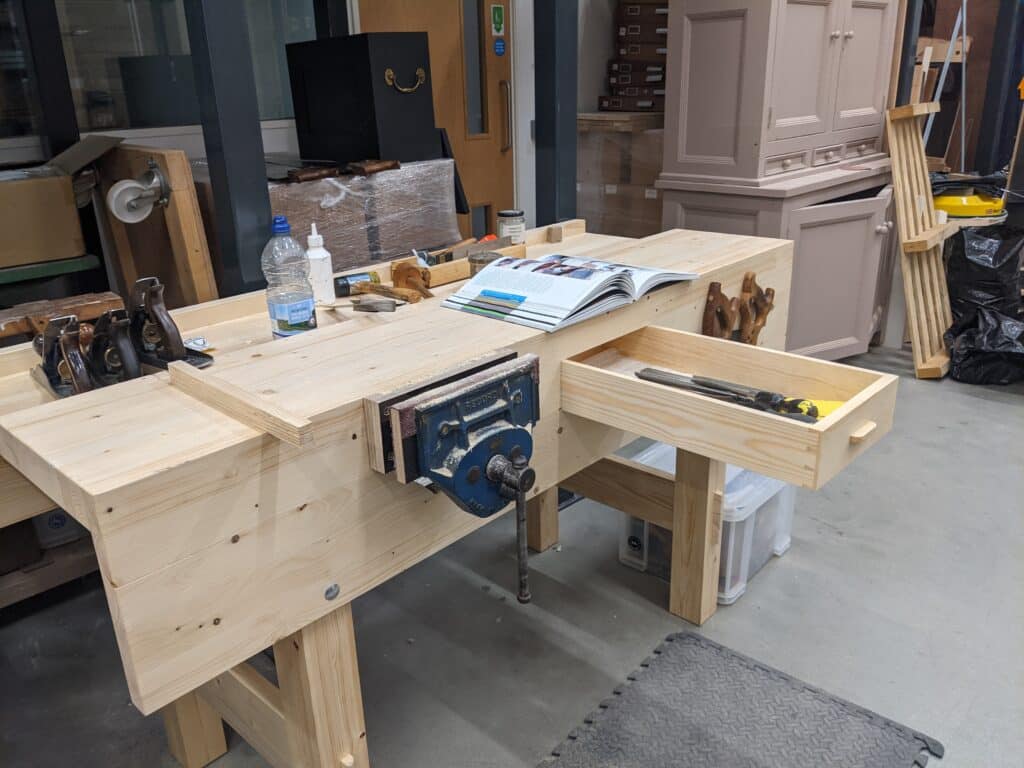
The essence of his being there at the bench divides off into essential elements. He is currently testing my written instructions in how-to’s I wrote over the decades and so the steps provide a planned and strategic way of making. But without them, given an order for one of those project-based how-to’s, he would create precisely the same steps for himself by himslef. I have worked for 30 years to encapsulate those elements from my life to prepare, plan and make any and every piece I make. Beyond the pages he’s following though are the unwritten essentials of order. No matter how untidy a workbench is, or the placement of tools, there are elements of work and working that just cannot be defied, tools that cannot be replaced by others or adapted, methods and techniques that can never be ignored no matter what. The essence of good work is order. I find and always have found such things to be enthralling.
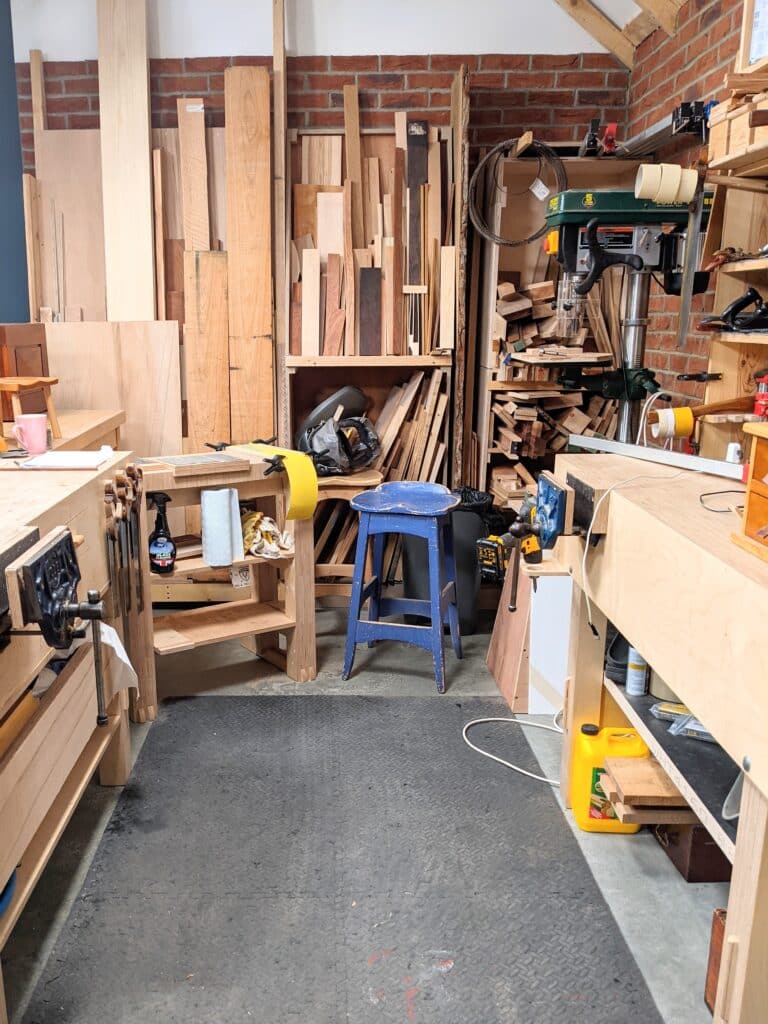
Key to peace in working is method. Without it, work and workmanship go to pot. The very nature of woodworking with hand tools demands the replacement of tools to their proper place on or near to hand at the workbench. My workbench is the most perfect tool support in every way; it organises me. I reach within a foot or two and every tool jumps up and into my hand as if my hands and the tools are polarised. John is either making or sharpening. No tool goes very far beyond that pristinely sharp edge or tooth for more than a few seconds. His level of sharpness is identical to mine.I would have no hesitation in allowing him to sharpen my tools for me. He is one of three or four people I might feel that about. Otherwise, no one touches my hand tools. No one!
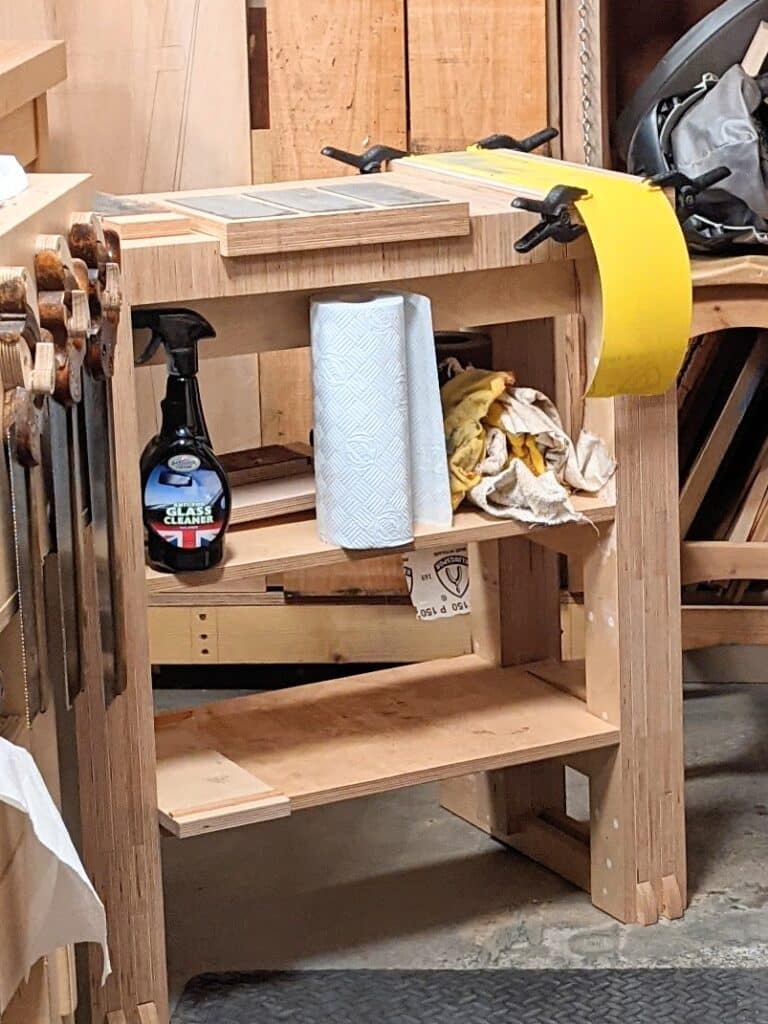
Flitting between sharpening and cutting is the essence of efficiency and skillful working demands that these two work in sympathy with one another. Clutter also demands attention and the recognition of natural breakpoints that don’t interrupt our flow of work or pattern of thought. There are points when we move tools aside in a cluster so as the maintain continuity, yes, but there are also those points when each tool must be returned to somewhere and the bench and floor swept to enable us some clear time to think fo the next steps. Ignoring the signs of dull edges, disorderliness and good maintenance on an ongoing minute-by-minute basis are signs of indecision that come from procrastination. This lazy disposition rarely leads to becoming a good crafter and mostly it can lead to an accident waiting to happen.
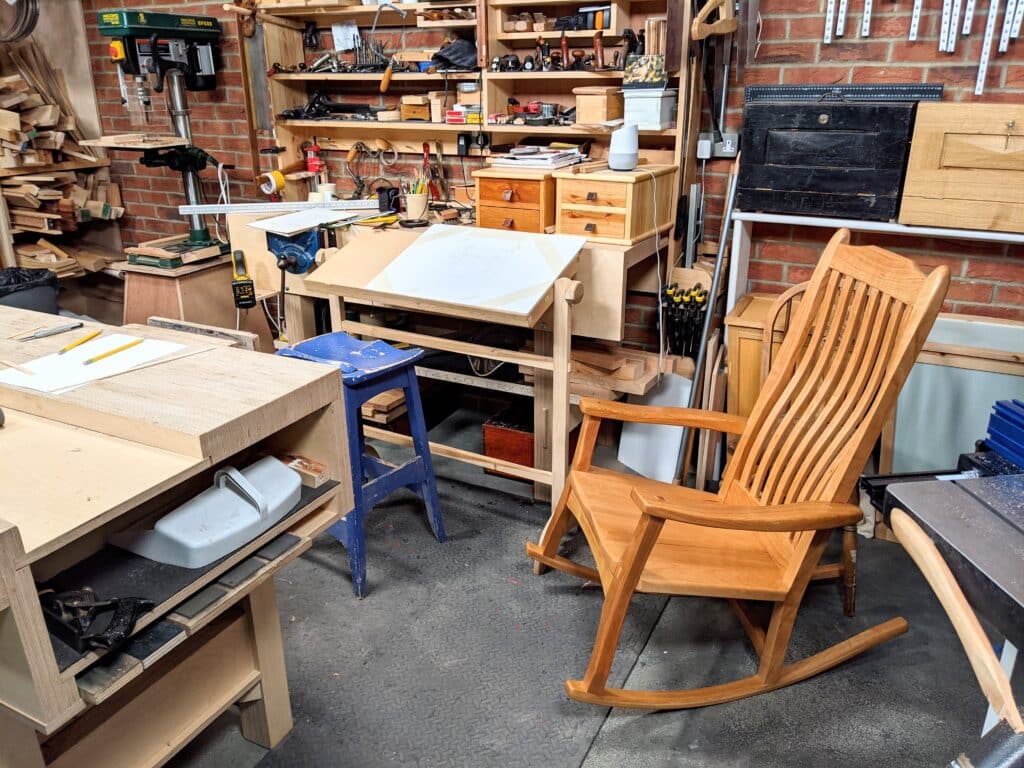
Detail comes with care and results from forethought. Forethought facilitates planning and stages get set for performance. I just redied my workspace after crafting four rocking chairs in quick and immediate succession. My next pieces for sellershome.com rotate like a three-dimensional Ferris wheel through my mind. I see wall clocks and coffee tables, bookshelves and even toyboxes glide in and out throughout my clean-up time. My planks lie in wait for my flipping and turning them for choosing their place in the whole. My mind settles on John’s box for a fifth time and I revisit the scene of my opening and closing the fall-front to hear the click of the catch or feel the slide of the dovetailed tills.
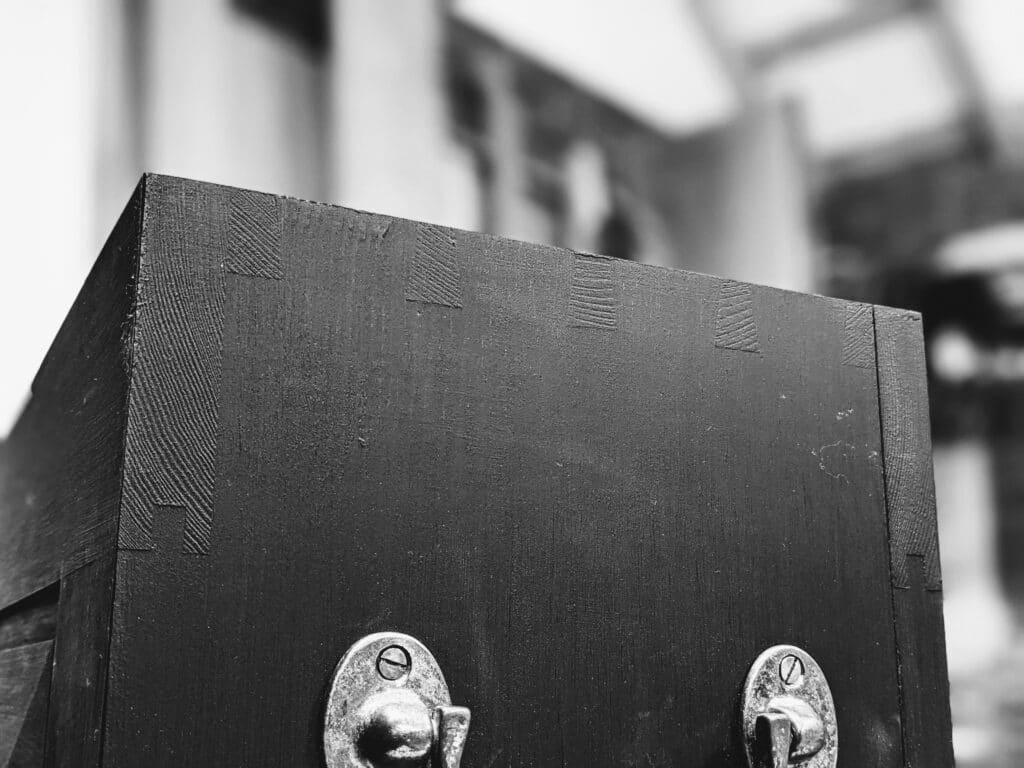
His tools are home inside in that belonging place that cushions them from the harsher extremes and exposure. It sits squarely on his workbench close to hand where he works. There is a crispness to it but, eventually, it will develop wear and marring from the nature of being there. There is a certain gladness that the tools are safely placed and stowed. This is why we do what we do using hand tools. It is about order, yes, but it is more about the organic processing that only hand tools provide us with.
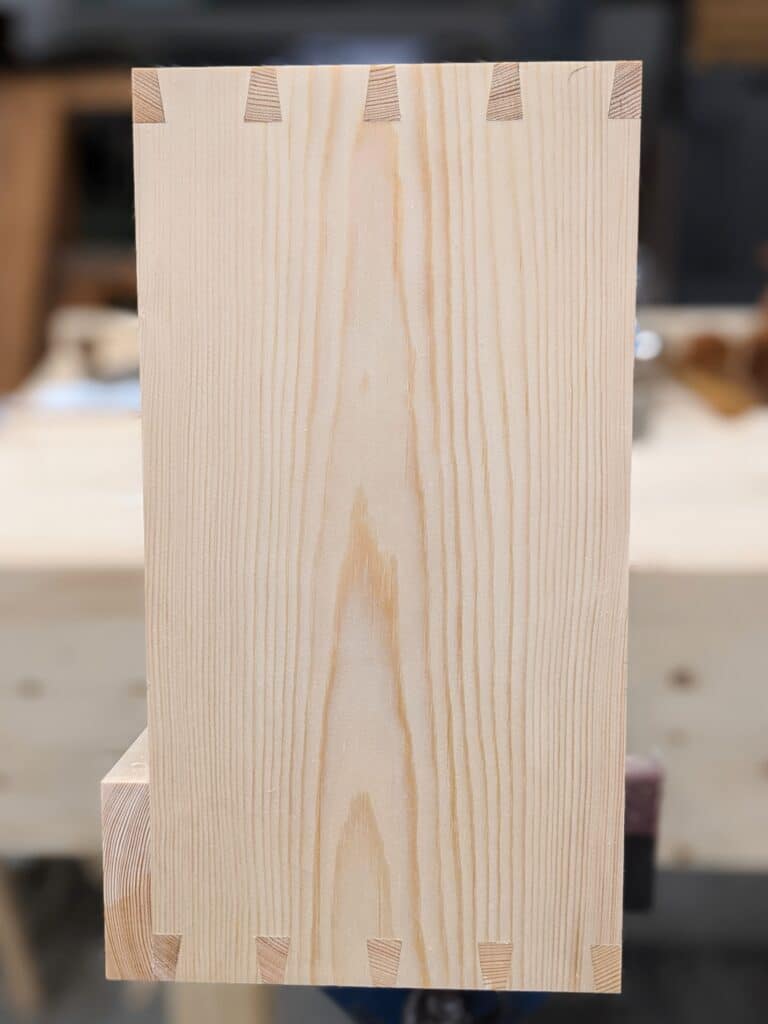
This is what sets the crafting artisan apart. It is by no means exclusivity that makes us exclusive, more that we cannot achieve what we achieve any other way. We cannot achieve the ultimate levels of satisfaction we strive for without using the exclusive tools we need. For this there is no substitute; the hand tool is never replaceable by any machine. That creates exclusivity where it is needed. It’s what we crafting artisans rely on. There just is no other way once you’ve been there!


I love the look behind the bench! I haven’t noticed it before, that you have another work bench behind you! I have seen it, but assumed it was “just” a support table. The sharpening station I’ve seen before, but just a glimpse so that I’ve forgotten it.
I have a suggestion: make a video about the work flow, seen from the angle in the third image – maybe even more “over your shoulder”. I’d love to be able to peek over your shoulder while you work.
I’m always learning new things by watching you, and other hand tool workers, work. The other day I planed an edge for a drawer, and some rising grain started to tear mid-cut. Just a few inches in length, then the grain dove. I spun the plane around, dragging it by the knob over the offending area. Pristine surface!
I’m making a support table now, and it will serve as a sharpening station too. Ready to go at all times, no need to move things about on the bench for a tune up. Efficient. Sort of the hand tool analogy to the power tool arguments? It is “more efficient and faster”… If time was of the essence for a hobbyist woodworker…
You are giving John the very best compliment and acknowledgement you could ever offer, when you state that he can sharpen your tools for you.
It is the same for me – nobody will be allowed to do tuneup on my guitar except for myself and one other person. He has proven himself, and his results are as good, if not better, than mine.
That is vital.
Thank you for another glimpse of your work zone. Please do it more often! Showing your work from the front of the bench is not the whole story. A secondary camera angle could be very informative. The “in front of the bench” angle is of course very good, but it is limiting. As if George would keep you in front of the bench, never showing you anything from his angle. You would’ve missed a lot of fine details, would you not?
I don’t know, but I imagine a master showing something to an apprentice would keep the apprentice next to him, not in front of him, so that both would see the same.
Again, thank you for the glimpse of your creative space. I’m honored to find it familiar!
I noticed the same things! Paul, I would love to see some “anatomy” of that side table/sharpening station. Maybe a project video? (Or did I miss that vid?) It looks very sturdy and useful in the shop.
That would be nice. An alternative is having a large mirror on top of him, not unlike in cooking shows, that gives us another angle to look from. The top!
The work there is amazing. I know I’ll never come close to that sort of perfection, my bar is set a lot lower (till I finally work out how to sharpen blades)
Question, what book is it that John was using? Just did a quick look on Amazon uk for your books and had a laugh at the prices people are looking for.
Your knowledge and teaching is priceless but someone is asking for £1,253 for “essential hardworking tools”
Who is your recommended seller of your books?
Thank you
We are. No one else can sell them. For Essential Woodworking Hand Tools go to rokesmith.com here.
Paul, you should make a video for a small book shelf for the shop, sized to fit the book! 🙂 I know I will make a small “shop library”, and Essential Woodworking Hand Tools will be placed there! Got my copy years ago.
What a reference to have in the shop!
Can’t believe I asked where I can buy the book when there was a link on the web page.
One book purchased.
Thank you.
Hi Paul
If i place an order of this book, will it ship anywhere in the world ?
I am based out of India.
Thanks.
It will indeed, Rajesh.
“essential hardworking tools”
Freudian slip? If so, a fortuitous one.
Is it just the angle of the picture, or does that bench have the vise more in the center than usual?
The angle, yes. No, it is exactly as the one in the videos and the book etc.
I know I have been inspired by all of you who are sharing your experiences. As to keeping order in the shop, it can be dodgy for me to keep order. At times I have worked dangerously. Fortunately I have survived. I will think of this blog from now on when I overreach for something or when I may be putting myself at risk
. Recently I found an old kitchen leaf table at the dump. It is well over a hundred years old so it is built well. This table will make a great work platform and tool organiser while I am working. Next a metal work box,on wheels with a drawer, appeared at the dump. Tools will fit very well on its shelves and drawer. I noticed an old beer fluorescent advertising light in the metal bin; this made a perfect fish pole holder for six fishing poles. It had to be modified, including drilling and tapping holes to position holder arms. Sometimes my wife is upset because I bring things home, but after they are used for various things she is happy. If things keep turning up at the dump, I will never be able to build all the nice organising things that Paul shows us how to build.
One more thing! I noticed Brian Dwyer made a comment. I know a Brian Dwyer from the Adirondacks and he is one of my dearest friends
“I reach within a foot or two and every tool jumps up and into my hand as if my hands and the tools are polarised.”
I know what you are trying to say and agree, but it also reminds me of something that happened to me in my early teens, when I began tinkering with electronics more seriously. It was at that point where you think you’ve got routine… but don’t actually have it yet. My soldering iron was always in the same spot on the workbench, on a homemade stand (bit of bent, V-shaped welding rod on a plywood plank). I got into the bad habit of grabbing the iron without looking at it. Until that one time I grabbed it not at the handle, but at the wrong end, the hot end. I can still picture vividly that particular smell of burning meat.
It’s amazing how long it takes for the brain to receive the signal that something is very wrong, then re-direct your gaze to the offending hand, until finally the brain sends the signal to your hand to let go of the darn thing immediately. It seemed like an eternity, with everything happening in slow-motion. Ended up with quite a nasty burn in my hand that bothered me for a few weeks. It’s a mistake I didn’t make twice.
So yes, tools always in their proper place, but definitely always visually verify when you reach for or grab one, lest a tool jumps into your hand in a way you don’t fancy. With the pointy end, instead of the handly end, for example…
I saw the exact thing happen to a coworker. We both worked in electronics shop and had butane Ultratorches that we soldered with all day. The main full length workbench was carpeted with a couple of formica squares for soldering on. If the soldering iron was set on the carpet, it would melt the carpet, even if off(took several minutes to cool off). Well, instead of resting the torch on the formica, my coworker set his torch down on the carpet but only the handle, leaving the hot iron part hanging over the edge towards the shop. A few minutes later he walks by on the way to his toolbox and grabs the torch by the iron side! I heard the sizzle and smelled the charring flesh. It took me a few seconds to realize what he was doing, and looked at his face and it took him a couple seconds as well. I saw his face as he realized. That was pretty bad.
I never cared for the large English apron on the workbench till today seeing it in all it’s glory. Then it hit me. The body having a connection a base to steady the body for control instead of negative space .Some of us need all the body control we can get even as we age.